The Pine Processionary Carterpillar - Taumetopoea pityocampa
Parasites and insects
• Insect traps to protect your plants
• Selective trap for Asian Hornet
• Pine Processionary Carterpillar
• The red spider mite
• Mistletoe
• Lichen
• Flea Beetles
• Caterpillars
• Leafhoppers
• Hard-shelled scale insects
• Mealy bugs
• False caterpillars (Sawfly)
• White flies
• Aphids
• Woolly aphids
• Shield bugs (Stink bugs)
• Prevention
• Diagnostic
• Cure
• Deficiencies
• Fungus
• Diseases
• Plant Bugs
The Pine Tree Processionary Caterpillar is invading France, little by little, except Northern and cold, mountainous areas. It is easily recognisable in winter thanks to its nests, kind of big, white cocoons which are hanging on Pine trees (Maritime, Umbrella Pine, Corsican Pine, Pinus Nigra …) but also Cedar trees.
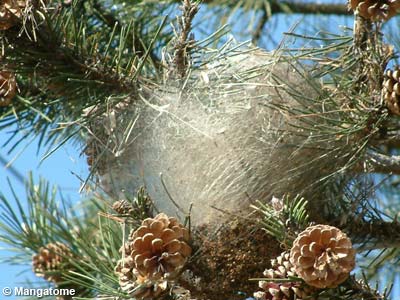
Nests of Pine Processionary Carterpillar - Taumetopoea pityocampa
At the end of winter, the caterpillars come down from their cocoons in their hundred, forming a long nose-to-tail column on the ground, to go bury themselves into the soil. They will only come out in summer, transformed in butterflies, to mate, and lay their eggs which will, in their turn, become caterpillars. (A female can lay up to 300 eggs).
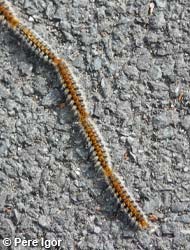
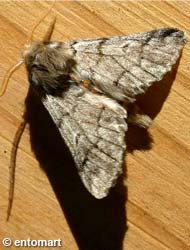
These caterpillars have very few predators and are a real danger for humans and mammals. Indeed they release a cloud of irritating hairs, when stressed, which can come into contact with the skin, the eyes or the airway. This can go from a simple urticarial case to an allergic reaction. I case of contact with the eyes, or the airway it is imperative to consult a doctor as a matter of urgency. For animals such as cats, dogs and horses which could graze the grass on the caterpillars’ way, in case of contact with the processionnary caterpillars, a consultation to the veterinary surgeon as a matter of urgency is required to limit tissues’ necrosis (tongue and mucous membranes) and save the animal.
So we understand why it is essential to fight against these caterpillars in parks and gardens, as do our villages and municipalities on communal grounds.
The different fighting means
Several fighting means to get rid of these undesirable, without using chemicals, are available.
The first one consists of removing the nests from the trees and burning them (mechanical clearing of caterpillars). This method is suitable on smaller sized trees but remains dangerous: risk of falling, enter in contact with the itching hairs…
Also be careful when burning the nests of not finding yourself in the wind direction to avoid being covered with itching, irritating hairs…
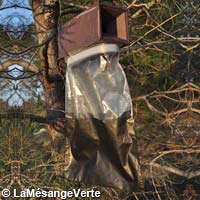
Pheromone traps placed on pine
Pheromone traps placed in summer are very useful to catch males and therefore avoid a great deal of female fecundation. This also allows you to participate in national study programs by relaying weekly the number of male caught.
• See how the trap works
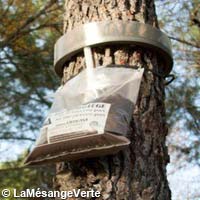
Eco-traps placed on pine
As for Eco-traps, they are useful to catch caterpillars which come out of their nest, before they reach the ground. Placed approximately 2 metres high on trees which have nests, they have a kind of collar which surrounds the trunk and direct the caterpillars towards a bag in which they fall and die of asphyxia. Their effectiveness is higher than 97% (source INRA). They are chemicals free and reusable.
• See how the Eco-trap functions
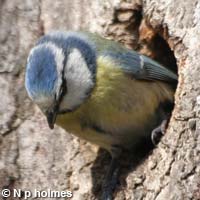
Blue tit - Cyanistes caeruleus
Lastly, the auxiliary fauna, such as tits and bats allows to considerably reduce the number of caterpillars in the nests. Placing a few nest boxes near infested zones allows attracting this very useful wildlife.
In using two or more of these fighting means, you optimize the result and significantly reduce the population of Processionary Caterpillars.
Fighting Periods
| January | February | March | April | May | June | July | August | September | October | November | December |
| Pheromones traps | |||||||||||
| Eco-trap | Eco-trap | ||||||||||
| Mechanical | Mechanical removing | ||||||||||
| Putting up Blue Tits nest boxes | |||||||||||














































































































































































































































